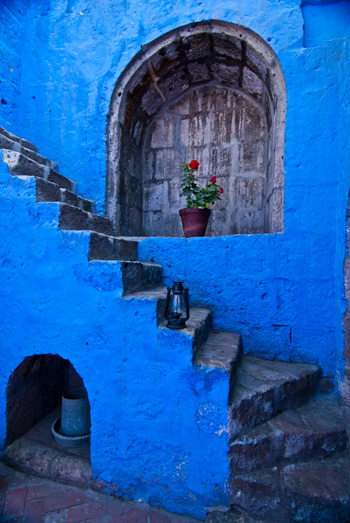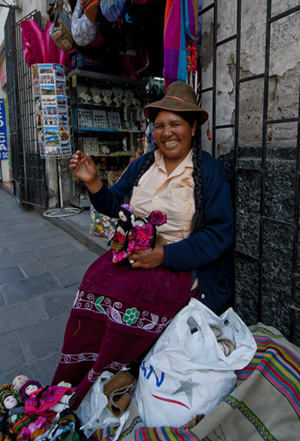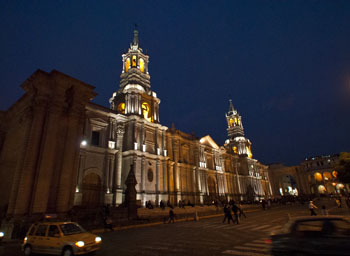Arequipa, the good, the bad, and the sublime
I’ve been in Arequipa for three days after an arduous 16 hour bus ride down the coast of Peru and into the high desert that surrounds Arequipa. It is known as the white city of the Andes because it is back-dropped by three magnificent volcanoes and because in previous centuries its buildings were all made of sillar, which is white volcanic stone. Even the desert around here is of white sand.

But regardless of the scenery, it’s the people of Arequipa – the Arequipenos – that I have fallen in love with. The love affair began with a call to an Arequipa guest house when I was in Lima. The owner didn’t have a spot for me, but she booked my stay at the Los Andes Hostel and also politely offered English classes. I’ve had three days of crash course 3 hours a day. I’m still not fluent, but I can fumble my way through an ‘Ola’ at least.

I’ve met lovely Indian women on the cobbled streets and murdered some Spanish to share bits of our lives. I’ve had a tour guide wait for me after a sublime tour through the Monastereo de Santa Catalina after dark, to gift me with a book about the place because we got to talking and her daughter has been gone for two months to my city of Vancouver and mom is worried. I offered to get in touch with her daughter when I get home. There have been so many more. The people smiling on the street, the man in the hostel who solved the mystery of why my newly minted Peruvian cell phone wouldn’t call Canada, the fantastic English teacher (how can you not love a man called Fabrizio), and he super nice hotel staff. And then here was the police man – but I’ll get to him.
The old part of Arequipa is built around a lovely square that is continually flocked with both pigeons and people. I mean this is the most use I have ever seen out of a park. During daylight hours every bench is filled and so is every inch of grass. The Pigeons own the pavement. Families chase after small children and the huge cathedral towers over it all. On the other three side of the Plaza are lovely arched galleries that shade from the sun of the rain that apparently comes heavily in January/February.

You see signs of the rains at the Monastery and at other old buildings as well. Water damage to precious old murals painted on the rock walls. Of course this is relatively minor compared to the damage earthquakes have caused. Both of the fine old monasteries I visited have undergone extensive restoration to deal with it.
The Monastereo de Santa Catalina is painted terra cotta and yellow and Mediterranean blue. It is filled with far too many niches and corners that caught my camera’s eye. I spent three hours there on my own one morning, just wandering through the silences. This monastery is still in use, though the number of nuns has significantly decreased from its heyday. These nuns were from wealthy families and had to pay handsome annual dowries to the monastery. They had their own apartments (the size and opulence dependent on their family’s wealth) as well as servants (read, slaves) and held dances and musical interludes. Not very nunnish, if you ask me.
Anyway, that all changed in the restoration and they shifted to more austere living arrangements, but still the place is filled with flowers and Moorish arches and hidden alcoves and fountains and goldfish and remaining nun have their part of the Monastery away from the world.
So I know you are all wondering about the policeman.
This morning, I went to the Museo de Arte Virreinal de Santa Teresa, a museum set in another monastery, that also has its nuns still in residence though they are depleted from 250 to 21 (apparently a specifically chosen number). Again I had a wonderful time and bought a lovely pumpkin-filled pastry to eat on my way home. So I’m happily walking down the street with camera bag and purse secured at my side and his man walks past. No problem. Suddenly he turns and rushes at me and slams into my side, while grabbing for the purse, but to take it, he basically has to take me, too, because it’s slung across my body. So he grabs my Buddha necklace that I never take off, and he rips it off my neck and takes off himself.
A man yells and runs after him. The people on the block are all yelling. They guide me to the police and so I end up with the tourist police and my policeman. Thankfully he spoke English.
So I gave my report and I won’t bore you with all the details, but will only say that I have had more apologies on behalf of Arequipenos, than you can shake a stick at. But the policeman was very kind. He took my information and the last time I saw him to pick up the formal statement for insurance purposes, he asked me (shyly) you are a writer? Yes.
Like books? Yes, I say.
What kind of books? I tell him.
Could I find your books on the internet? Yes.
Could I read them there? Again, yes. So I had to tell him about each one.
Which just goes to show that good can come from bad. Yes, I was robbed, but I gained an audience.
(I’m sending him a complimentary copy of one of my books.)










